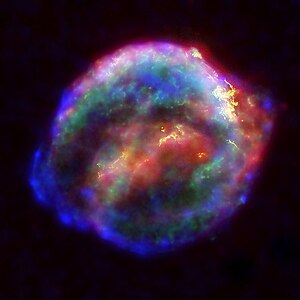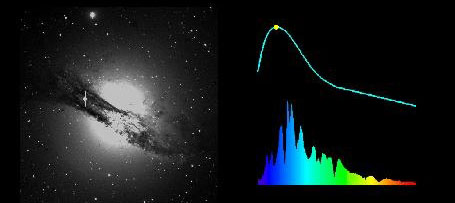So I’m at a party a dozen years ago in Oakland, California—I think it’s in my own living room, though I can’t remember for sure. Downstairs the salsa music is blaring, but up here people are gathered in threes and fours chatting. I join a few friends grouped around a man I just met.
“Well, Saul,” one of them is asking, “how is your research going? Have you discovered anything exciting lately?”
Everybody grins. Put the scientist on the spot. This is what party talk sounds like when there’s a physicist in the crowd.
Saul’s face lights up. “As a matter of fact,” he replies, beaming, “we do have some exciting news. We all know that the universe is expanding, right? But we always thought that the speed of expansion was slowing down. Well, we’re just now finding out”—he pauses for dramatic effect, his face glowing—”that it’s not slowing down at all! In fact, it’s speeding up!”
And that’s how I learned about the discovery that just won the 2011 Nobel Prize in Physics, the discovery that our speedy universe, far from winding down to to a slow extinction, is in fact speeding up; its rate of expansion is increasing. Two competing astrophysics teams came up with the same results at about the same time a dozen years ago, and the leaders of those two teams shared this year’s prize. The friend-of-a-friend in my living room was Saul Perlmutter, head of the Supernova Cosmology Project at Lawrence Berkeley Labs.
Saul and the other Nobel laureates received their prizes this month in Stockholm, and in honor of the occasion I listened to Saul’s November interview on Fresh Air with Terry Gross.
Saul began by explaining why everyone was shocked to find that the universe is expanding faster than before. If there was a Big Bang at the beginning, which set all the expansion in motion, and if all the stuff of the universe is attracted to each other through gravity, then over time—billions of years of time—that attraction should cause all the stuff to start coming back together again, and the rate of expansion should slow.
In fact, the research teams found the opposite. And it set akimbo some of the most basic understandings of the universe.
It would be like throwing an apple up into the air and expecting it to get pulled back down to earth by gravity. What we were seeing was more like throwing the apple up in the air, and it blasting off into space! Clearly, there’s something else going on here that was not part of our standard physics. Here was something that physics was just getting wrong!
So how do you explain this increasing speed? Many ideas are being put forward, one of which is called “dark energy.” Saul is quick to explain that physicists know next to nothing about what this dark energy is—or even if it is the right explanation.
Making up about three-quarters of the energy and mass of the universe, this new phenomenon has some strange properties. It is an energy associated with all of empty space. Unlike gravity, which works between objects, pulling them closer together,
this dark energy doesn’t really care about the objects; it’s in some sense a property of space itself, and space itself wants to reproduce faster and faster.
Space “reproducing itself.” The words conjure images of space burbling up between galaxies, endlessly creating more empty space, pushing all the known pieces of the universe farther and farther apart at an ever-faster rate.
Apparently the universe has been doing this only in the second half of its lifetime. It is still thought that its acceleration slowed down for the first nine billion years or so, but for some reason not yet understood, the universe turned to speeding up faster and faster over the past five billion years.
Is your mind boggled yet? If so, you’re in good company— with everyone else, including the physicists who spend their lives working on these questions. Saul says,
I sometimes think the people who go into this field are the ones who enjoy having their mind boggled at least once a day!
Terri Gross voices a question about the Big Bang that many people, if they stopped to think about it, have wondered: How can the universe, if it’s infinite, be expanding?
Saul responds that the very term Big Bang may be getting in the way because it leads us to imagine there was an original explosion of “stuff” out into empty space. And of course that doesn’t make sense because the universe was the empty space too. “So I’ve been trying out a different way of describing it,” he says.
Just talk about today. As far as we know, the universe at this moment could be infinite. You have galaxy after galaxy after galaxy as far as you want in any direction, with an average distance between those galaxies. When we say that the universe is expanding, all we really mean is that we’re pumping a little extra space in between all those galaxies. So every distance is getting a little bit bigger.
The universe is stretching, endlessly stretching. Creating more space in between galaxies, in a richly mysterious process that we have yet to fathom. As Saul said in his Nobel banquet speech,
Perhaps the only thing better, for a scientist, than finding a crucial piece of a puzzle that completes a picture, is finding a piece that doesn’t fit at all—and tells us that there is a whole new part of the puzzle that we haven’t even imagined yet, and the scene of the puzzle is bigger, richer than we ever thought.
Always more space, not less. More stretching, more possibilities in all directions. Our universe is always expanding.
Just because it can.
Just because it loves creating something new.
For more information:
- Saul and other astrophysicists measure the universe’s rate of expansion by looking at the colors of supernova explosions. Click on the image for more info.
- For more detail on how supernovae reveal the secret of the age of the universe, see Saul’s article in Physics Today from 2003, available on a link from this page.
- And for a flavor of the celebrations in Stockholm, see photos from the 2011 Nobel week, with links to interviews and speeches and lectures by the prizewinners.

